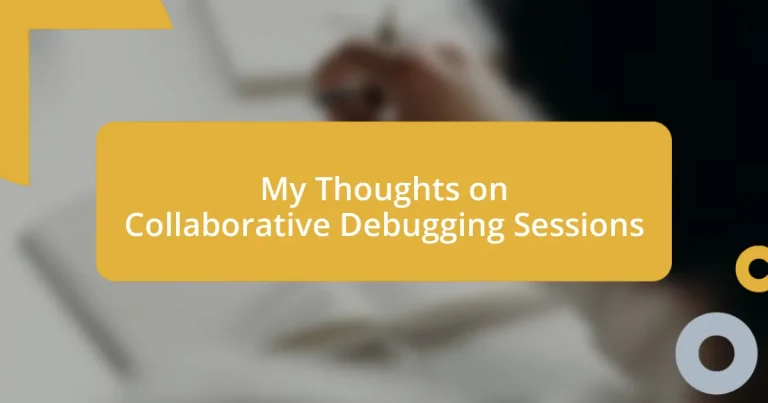Key takeaways:
- Collaborative debugging sessions enhance problem-solving through diverse perspectives and knowledge sharing, leading to quicker resolutions.
- Key roles in debugging teams include Mediators, Technical Leads, and Fresh Perspectives, each contributing unique insights to foster collaboration.
- Structured communication and the use of appropriate tools, such as live sharing platforms, enhance teamwork and efficiency during debugging sessions.
- Establishing clear roles, conducting regular check-ins, and promoting a culture of openness are essential for successful collaborative debugging.
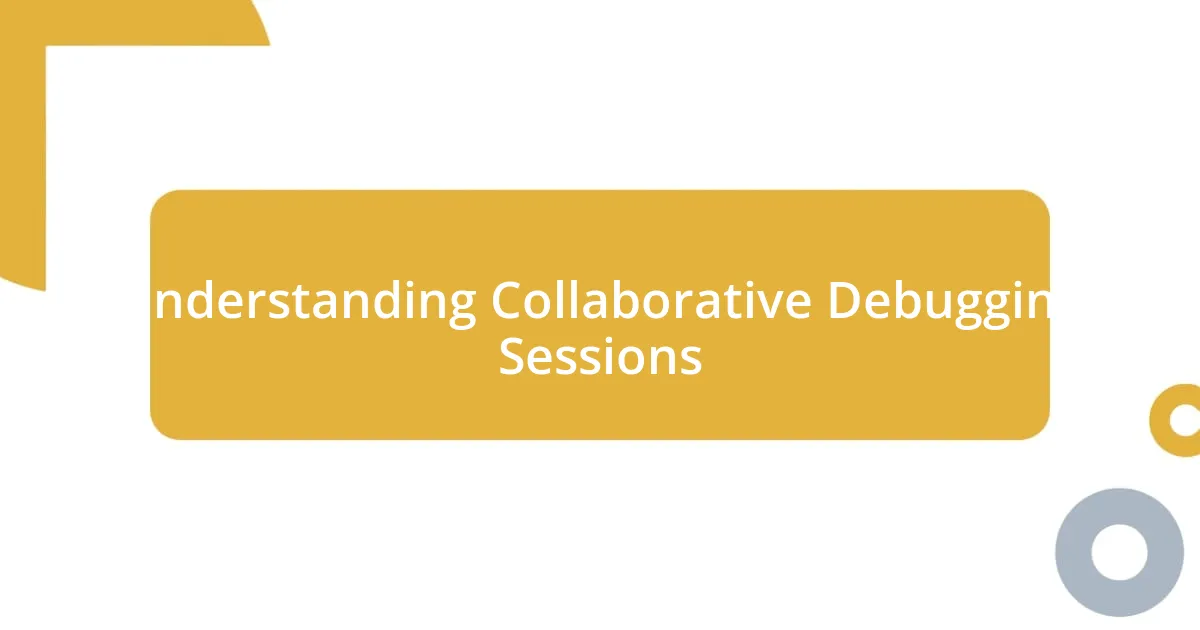
Understanding Collaborative Debugging Sessions
Collaborative debugging sessions are fascinating because they bring together diverse minds to tackle complex issues. I remember a time when I was stuck on a particularly nasty bug and decided to invite a colleague for a quick brainstorming session. What started as a simple fix turned into a riveting discussion that not only solved the problem but also sparked new ideas for improving our overall coding practices.
In these sessions, the power of perspective really shines through. Each participant brings their own experiences, which can lead to innovative solutions you might not have considered alone. Have you ever noticed how joint problem-solving can sometimes feel like a game of chess, where your next move is inspired by your partner’s insights? I’ve found that the back-and-forth dialogue often uncovers the root cause of issues much quicker than going solo.
Moreover, there’s something uniquely energizing about collaborating with others. The shared sense of purpose fuels motivation, making the debugging process less daunting. I often feel a burst of relief when someone else helps clarify a convoluted piece of code; it’s like a weight is lifted off my shoulders. In those moments, I see how teamwork not only enhances problem-solving but also fosters a sense of camaraderie that can make even the toughest debugging challenges feel manageable.
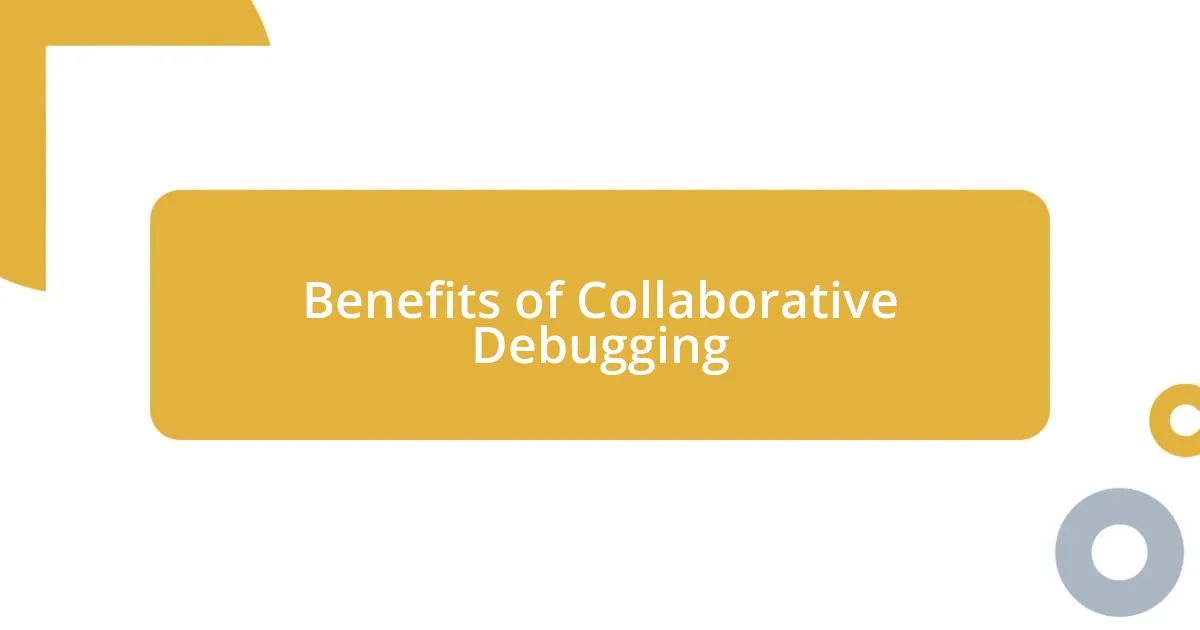
Benefits of Collaborative Debugging
Collaborative debugging sessions come with so many benefits that I appreciate as both a developer and a team player. One of the most striking advantages is the rapid knowledge transfer that occurs in real-time discussions. I recall a session where a colleague introduced me to a debugging tool I had never used before. Not only did it speed up the process of finding the bug, but it also enriched my skill set—something I wouldn’t have experienced if I’d tackled the issue alone.
Here are some of the key benefits I’ve observed:
- Enhanced Problem-Solving: Different perspectives lead to innovative solutions.
- Skill Development: Team members learn from each other’s experiences and tools.
- Increased Motivational Boost: Working together can make the process feel more engaging and less isolating.
- Faster Resolution: Issues are often resolved more quickly due to collaborative efforts.
- Strengthened Team Bonding: Shared challenges build camaraderie and trust among team members.
Feeling that collective energy is like having a support system right there with you, which is invaluable during particularly stubborn debugging sessions. I find comfort in knowing I’m not alone, and that shared experience often leads to a greater sense of achievement once we’ve solved the problem together. Just thinking about a session where we celebrated a hard-earned fix makes me realize how collaborative efforts turn challenges into triumphs.
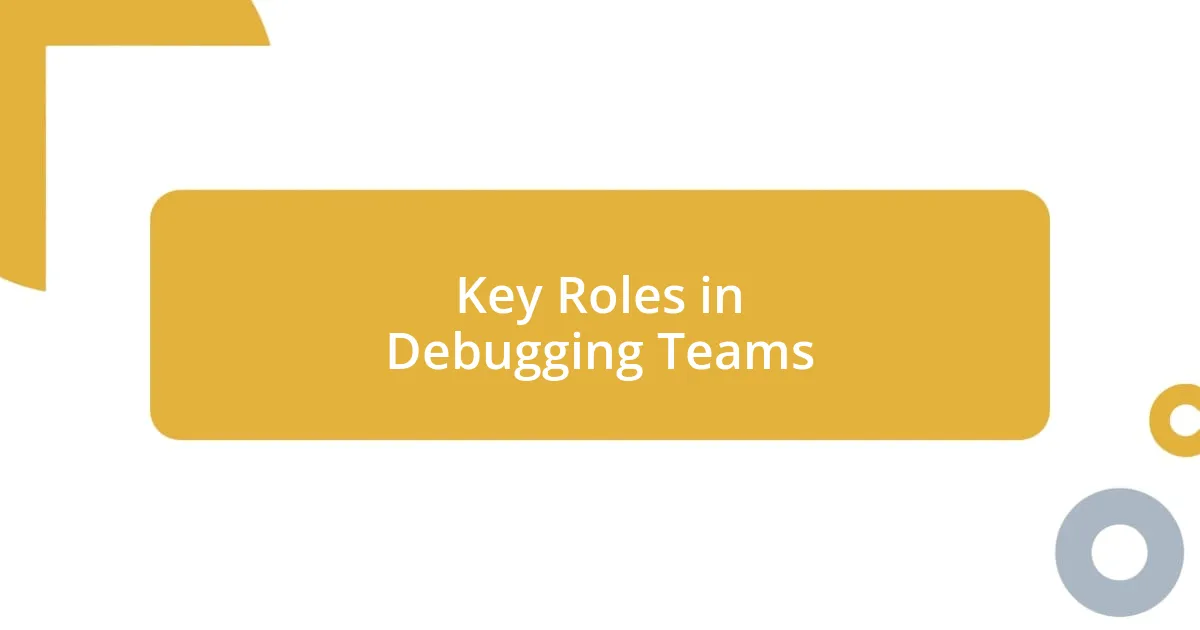
Key Roles in Debugging Teams
In any debugging team, each member plays a unique role that contributes to the overall success of the session. For instance, I often take on the role of the “Mediator,” facilitating communication between team members with different approaches. During one particular session, it became clear that some of us were bogged down by technical jargon, while others were struggling to understand the context. Stepping in to bridge that gap not only helped clarify the issue but also fostered an inclusive environment where everyone felt heard.
The “Technical Lead” is another critical role I’ve encountered. This person usually has a deep understanding of the codebase and can pinpoint where things might be going wrong. I remember one time when my colleague stepped in, his experience shining through as he quickly identified a logical flaw that had eluded the rest of us. Having someone with that level of expertise can dramatically enhance the efficiency of a debugging session.
Lastly, don’t underestimate the value of the “Fresh Perspective,” someone who might not be as familiar with the project but can offer new insights. I once attended a debugging session where a new intern identified a simple, yet overlooked, variable misconfiguration. Their fresh eyes brought an innovative viewpoint, reminding me that participation isn’t exclusively for experienced team members. Encouraging input from all roles can lead to breakthroughs that we might miss focusing solely on our own experiences.
| Role | Description |
|---|---|
| Mediator | Facilitates discussion and ensures clear communication among team members. |
| Technical Lead | Holds deep technical knowledge and guides the team in identifying complex issues. |
| Fresh Perspective | Offers insights from a less familiar angle, often leading to innovative solutions. |
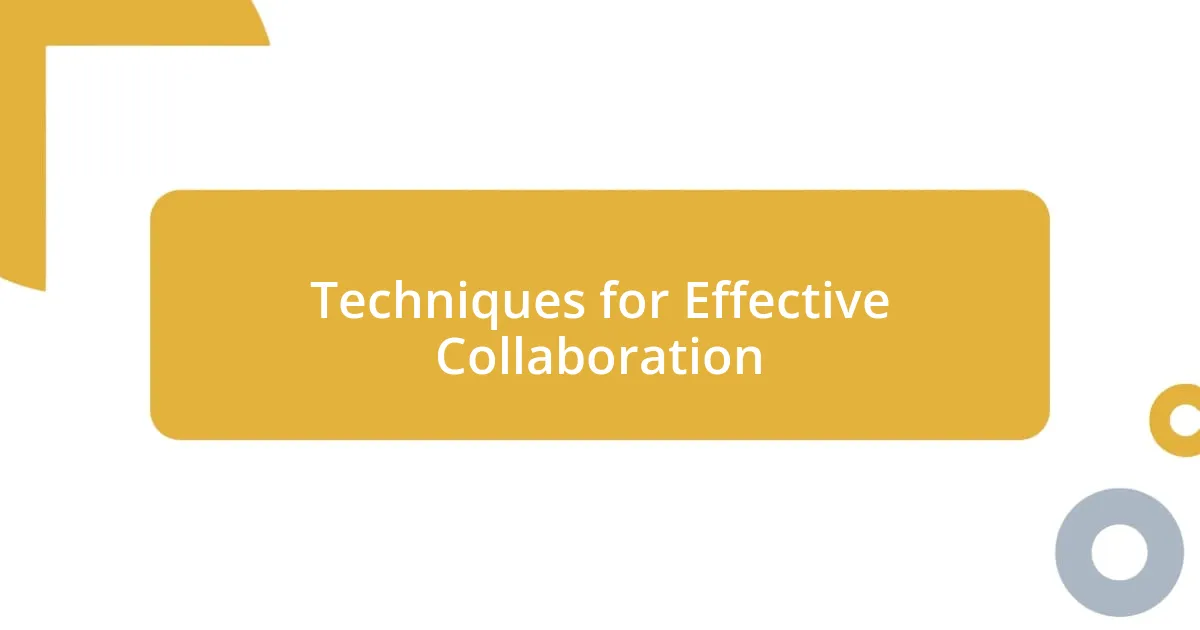
Techniques for Effective Collaboration
When I think about keeping a collaborative debugging session efficient, I quickly realize the value of structured communication. Establishing clear guidelines for discussions—like agreeing on who speaks first or using a shared digital whiteboard—can streamline the process. I remember one session where we implemented a simple round-robin system for sharing ideas; it not only kept everyone engaged but also minimized interruptions. Isn’t it interesting how a little structure can foster creativity and focus?
Engaging visuals can also enhance collaboration tremendously. Utilizing tools like code-sharing platforms or screen sharing allows everyone to see the same context, making it easier to follow along. I recall a time when we used a shared coding environment, and it felt like we were all in the trenches together. I could track real-time changes while offering input, resulting in more cohesive problem-solving. Have you ever noticed how seeing someone else’s thought process can spark your own ideas?
Lastly, I believe in the importance of building a collaborative environment where feedback is constructive and valued. During one session, we made it a point to celebrate small wins—like identifying a bug—alongside openly discussing areas for improvement. This not only boosted morale but solidified a culture of trust and learning. Reflecting on that time, I feel that when team members know their contributions matter, they’re more likely to invest their energy into the collaborative process. Wouldn’t you agree that an appreciative atmosphere breeds better teamwork?
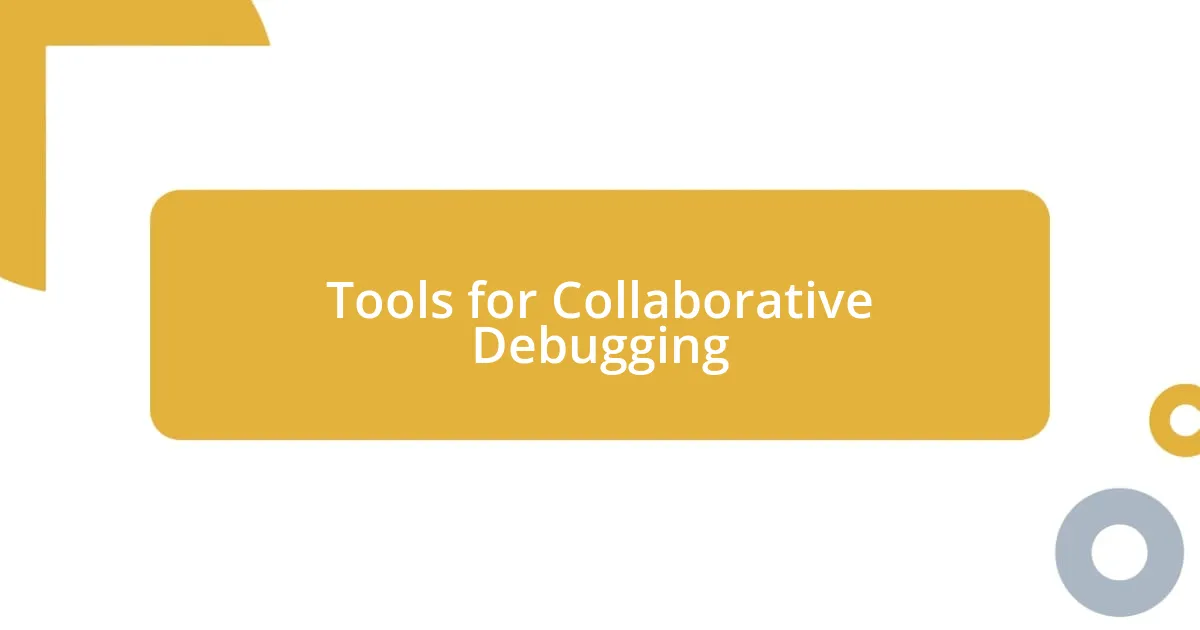
Tools for Collaborative Debugging
When it comes to tools for collaborative debugging, I find that the right technology can significantly enhance teamwork. For instance, I once used a tool called Visual Studio Live Share during a session with my team. It allowed us to share our coding environment in real time, enabling us to see each other’s edits instantly. This kind of immediate feedback was invaluable; it felt like we were all connected, troubleshooting together as if we were in the same room. Have you ever experienced that kind of synergy in your own sessions?
Another essential tool I swear by is Slack or Microsoft Teams for communication. In one particularly challenging debugging episode, we created dedicated channels that allowed us to discuss specific issues without losing track of our main conversation threads. This made looking back at past discussions so much easier when we needed to recall ideas. I’ve realized that good communication in collaboration isn’t just about talking; it’s about capturing and organizing thoughts effectively. Isn’t it exciting to think how a simple tool can help you keep your team aligned and your focus sharp?
Lastly, don’t underestimate the power of version control systems like Git. While many view it strictly as a coding tool, I see it as a lifeline during collaborative debugging. I had an experience where a teammate reverted to a previous version of the code, allowing us to pinpoint when a bug was introduced. It was like having a safety net—we could experiment without fear of breaking the entire project. Seeing that process unfold reminded me of how powerful it is to have robust systems in place. Don’t you think that knowing you can backtrack makes tackling complex problems feel less daunting?
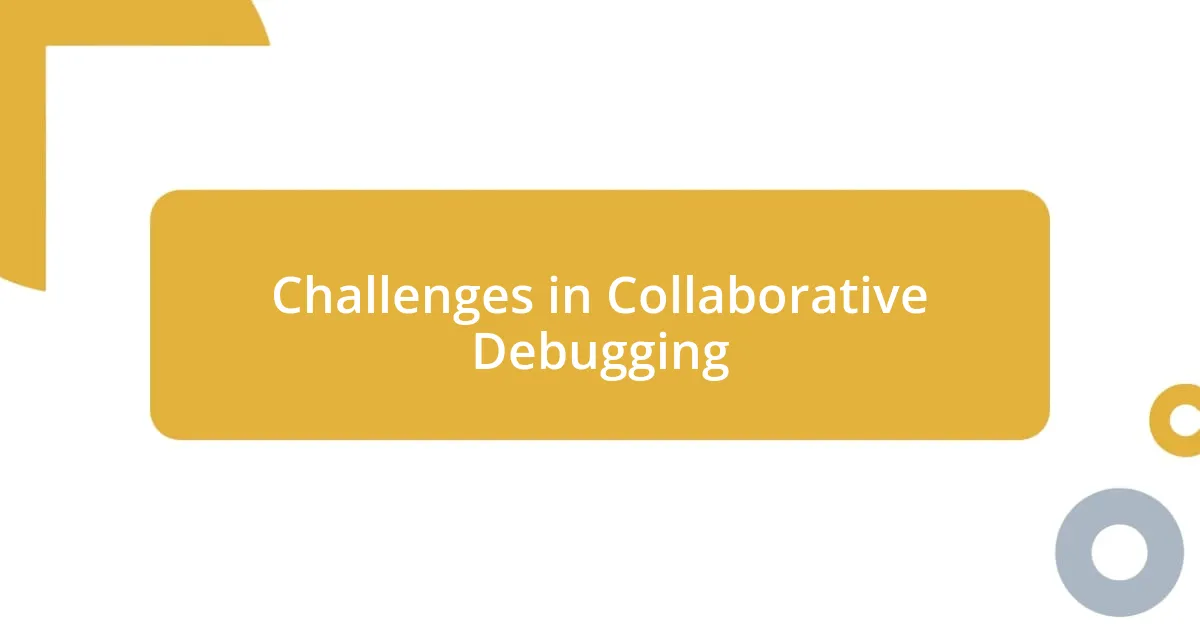
Challenges in Collaborative Debugging
Collaborative debugging certainly comes with its share of hurdles. One challenge I often encounter is differing levels of familiarity with the codebase among team members. I remember a session where my colleague had a solid grasp of the architecture, while another struggled to understand basic concepts. This created a frustrating dynamic where those who knew the code felt held back, making the process feel like a tug-of-war rather than a collaborative effort. Have you ever been in a situation where someone’s knowledge gap impeded the team’s progress?
Another significant challenge is managing differing communication styles. In one instance, I was paired with a team member who preferred straightforward, brief comments, while I thrived on detailed discussions. This mismatch caused confusion and misinterpretations, leading to an atmosphere of frustration. It reminded me how essential it is to establish a common language and style early on. Isn’t it fascinating how communication can either bridge gaps or create them in teamwork?
Lastly, time constraints can really add pressure during collaborative debugging sessions. I vividly recall a project where tight deadlines forced us to rush through our debugging strategy, resulting in overlooked errors and hasty fixes. It felt disheartening, especially when I knew that a more methodical approach could have saved us from future complications. Haven’t we all felt the weight of time crashing down on us when we know we could do better?
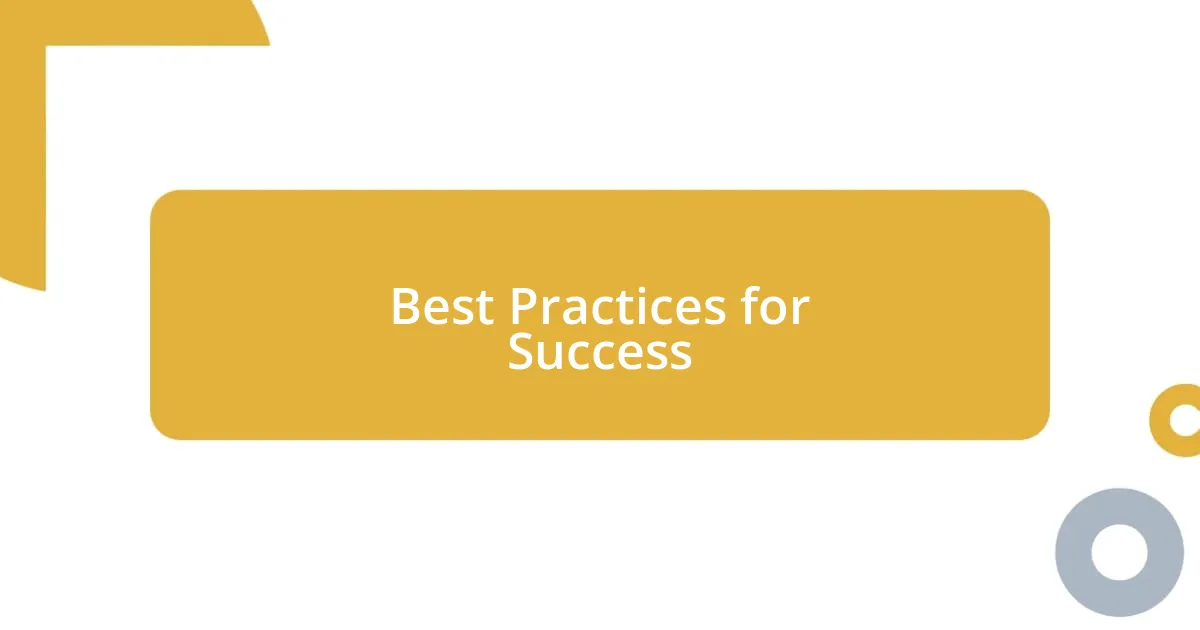
Best Practices for Success
To make collaborative debugging sessions truly effective, I’ve found that establishing clear roles can make a remarkable difference. During one session, we assigned specific tasks based on each team member’s strengths. I focused on synthesizing our findings while another colleague took charge of documenting our decisions. This specialized approach minimized confusion and streamlined our workflow. Have you ever thought about how clarity in roles can transform a chaotic process into a well-oiled machine?
Another best practice that I can’t stress enough is regular check-ins throughout the debugging session. In one memorable experience, taking just five minutes every half hour to regroup turned our chaotic pace into a more manageable rhythm. It allowed us to celebrate small victories and recalibrate our strategy when we hit roadblocks. Can you recall a time when a quick check-in saved your team from going down the wrong path?
Lastly, fostering a culture of openness and experimentation has proven invaluable. I remember a session where one team member proposed a completely alternative approach to a stubborn bug we were facing. At first, there was hesitation, but we decided to take a leap of faith and try their method. It ultimately led us to a solution we hadn’t even considered! This served as a powerful reminder that encouraging innovative thinking can turn problems into opportunities. Isn’t it clear that sometimes the best breakthroughs come from unexpected sources?












